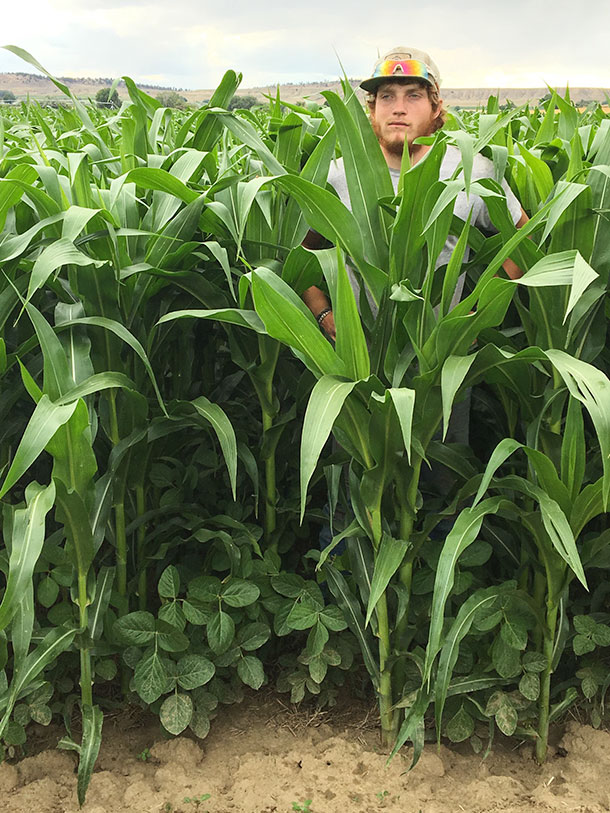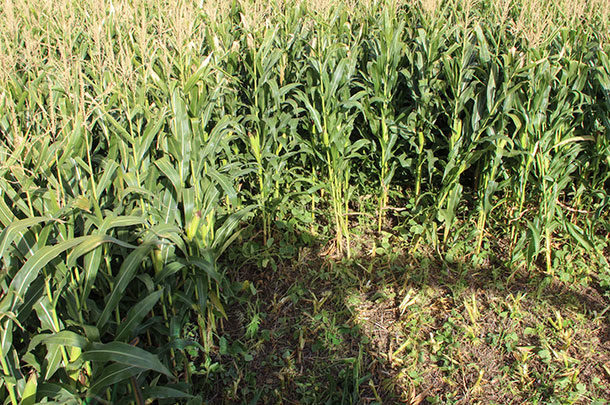Greg Schlemmer farms and ranches with his father near Fromberg, Montana (a town of about 500 people at an elevation of 3,628 feet). Schlemmer was in the local NRCS office one day working on a pivot irrigation cost-share program. The NRCS personnel invited him to a presentation on soil health, and Schlemmer says until that point, “I knew nothing about soil health.” He did, however, see the need for using less fuel and fewer chemicals. The presentation initiated his quest to learn more about soil health and ultimately led to “trying some different things.”
On 400 to 500 acres, Schlemmer Farms raises silage and hay to feed 18,000 head of cattle on two lots. Some cattle are custom fed for neighbors, and others are owned by Schlemmer Farms. Most are 400- to 1,000-pound beef cattle, but 1,100 head of mother cows are also housed in the lots. In light of the feedlot capacity, Schlemmer also buys a lot of silage from neighbors, as well. Most alfalfa hay is bought from other growers in the area.
His experiment started out as a way to cut nitrogen inputs to the corn crop, minimize weeds and harvest more sunlight. In about 2010, Schlemmer heard about a farmer in Iowa who started planting soybeans with corn. In 2012, he decided to conduct his own test on the theory. The first year, he used a regular corn planter in two passes, planting corn one way and then planting back across with a late-maturing soybean at a 45-degree angle. The crop produced well, but moving forward he didn’t want to make two passes.
He found a John Deere 1890 air seeder (CCS model, with two tanks mounted on top). He replumbed the hose so his front rank came off one tank and the rear rank came off the other tank. This allowed him to put different sprockets on it and plant corn at the population he desired. It’s not perfect. Schlemmer says, “It’s harder to get the accuracy with soybean seed, but I can get close, and it’s the corn density I’m after. Then I can plant into last year’s barley stubble with corn in 15-inch rows, and the soybeans are in 15-inch rows also, so the two together basically creates 7.5-inch rows.”
Schlemmer admits, “The air seeder probably isn’t the perfect unit to plant the corn. The spacing is a little off. I’m using 50,000 plant population per acre [corn], and it doesn’t seem to matter – the tonnage is still there at harvest.” He’s planting a 104,000 plant population per acre in soybeans, using a Roundup Ready variety, in basically a no-till or low-till environment.
Schlemmer isn’t trying to harvest beans; he’s after the forage tonnage and the nitrogen they produce. He plants a soybean with a relative maturity group of 3.2 or higher – a rating that might more commonly be grown in Kansas or Oklahoma. His soybeans seldom produce pods. He says, “The soybeans get 6 to 10 feet tall inside the corn rows. They just reach for the sun, kinda hang onto the corn and just keep going up. It’s like a forest – you can’t walk through it. I don’t even know if you could drive a car through it.”

After planting, Schlemmer sprays once for weeds, and says after that the weeds can’t compete with the canopy of the corn and soybeans, whereas some producers in his area spray corn two or three times under a pivot irrigation system. He also says the soybean seed cost is offset by the increase of 2 to 3 tons per acre in tonnage, as well as increased protein and total digestible nutrients in the silage tests.
For fertilizer, Schlemmer puts down 140 units of nitrogen (only what the corn plants require), without adding additional units, and uses manure applications in the pre-season. He says, “I would use the same 140 units if we weren’t putting down soybeans, but we’re not adding any more. I don’t cut down the first nitrogen rate for sugar beets initially [the rotation crop following corn], but I don’t need to side-dress anymore either. I have all the nitrogen I need now. I use the soybean nitrogen to build on.” He claims a 40- to 60-unit nitrogen benefit from growing soybeans. And he has the soil tests to back it up.
Schlemmer also says his water usage is down overall. “Everybody told me I’d be using more water,” he says, “but it doesn’t work that way, and I don’t know why it works that way; it just does. I don't know if it just creates its own atmosphere like a forest or jungle, but it’s always wet. You do irrigate maybe a week sooner in the spring (maybe all those plants in close proximity can’t go out as far for water and have to reach down for moisture, so you have to give them a little boost), but once they get knee-high or thigh-high, I use less water. Over the course of a year, it’s maybe an inch or two less.”
During harvest, Schlemmer makes adjustments to the silage harvest based on the presence of the soybeans. He says the silage that now includes soybeans is a “little wetter,” requiring a 70 percent moisture reading for harvest. To offset the moisture, he now uses a 90- to 91-day corn maturity variety rather than a 93- to 95-day maturity variety. He samples every five loads going into the silage pile for moisture, but he’s had no issues packing silage with soybeans in it, and says, “They really pack in there tight.”
Harvesting the corn silage and soybean crop required an equipment adjustment. Schlemmer now uses a rotary head on the chopper, processing 4 to 5 tons per minute. He says, “It’s like hitting a brick wall, it’s so thick. It slows the chopping speed because there’s so much material coming through.”
Now in his fourth year with a soybean and silage corn crop, Schlemmer uses a rotation of malt barley, corn and soybeans, sugar beets, then back to malt barley or other small grains, depending on market prices. Of the nitrogen soil benefits from the soybeans, Schlemmer says, “The sugar beets are amazing; the sugar is amazing; and the tons are amazing. I get 36- to 37-ton averages with close to 18 to 19 percent sugar in sugar beets, which is excellent for our area.”
On years when barley is grown, Schlemmer puts down cover crops with a five- to seven-way mix of radishes, volunteer barley, flax, turnips, forage collards, mung beans, sunflowers and winter peas. He cuts that for hay, getting about 3 tons to the acre. If he can’t get it to dry down, he chops it for additional silage. This year, he’ll try a plot with corn and red clover, spreading the clover on top and watering it in, then haying or grazing that to get a second crop, as he heard they’re having some luck with that in Pennsylvania.
Yes, it’s a little unconventional. But who can argue with success? ![]()

-
Lynn Jaynes
- Editor
- Progressive Forage
- Email Lynn Jaynes
PHOTO 1: Corn is planted in 15-inch rows, separated by rows of soybeans, essentially creating 7.5-inch rows through the field, planted in one pass with an air seeder.
PHOTO 2: To increase silage tonnage, Greg Schlemmer plants a late maturity soybean that seldom produces pods. The soybeans grow 6 to 10 feet tall inside the corn rows before harvest. Photos by Greg Schlemmer.











